Dive into the heart of the Himalayas with our detailed overview of the Top Trekking Routes in Bhutan, perfect for adventure enthusiasts craving both spiritual and physical challenges. From the demanding Snowman Trek, recognized as one of the world’s toughest High Altitude Treks in Bhutan, to the picturesque Druk Path Trek which connects ancient monasteries through beautiful landscapes, Bhutan presents a diverse array of trails. Each route, whether the secluded Laya Gasa Trek or the culturally enriching Merak Sakteng Trek, delivers breathtaking vistas, unique cultural insights, and a profound connection with nature. Whether you’re a seasoned trekker or simply inquisitive about the natural splendor, these options ensure an unparalleled adventure in the breathtaking settings of Bhutan.
At Amen Bhutan Tours and Treks, we pride ourselves on being the premier provider for those seeking to explore the Top Trekking Routes in Bhutan. Our expertly crafted itineraries and seasoned guides ensure that every trekker experiences the stunning beauty and thrilling challenges of High Altitude Treks in Bhutan. Whether you're aiming to navigate the famed Snowman Trek or enjoy the cultural depths of the Merak Sakteng Trek, our tours are designed to offer both safety and immersive adventure. Choose us for your next trekking adventure, and discover why we are considered the best in unlocking the mystical and majestic landscapes of Bhutan.
Snowman Trek
The Snowman Trek in Bhutan is often cited as one of the most challenging and exhilarating high-altitude treks in the world. This trek takes adventurers into one of the country’s most remote areas, offering breathtaking landscapes that are both rugged and pristine.
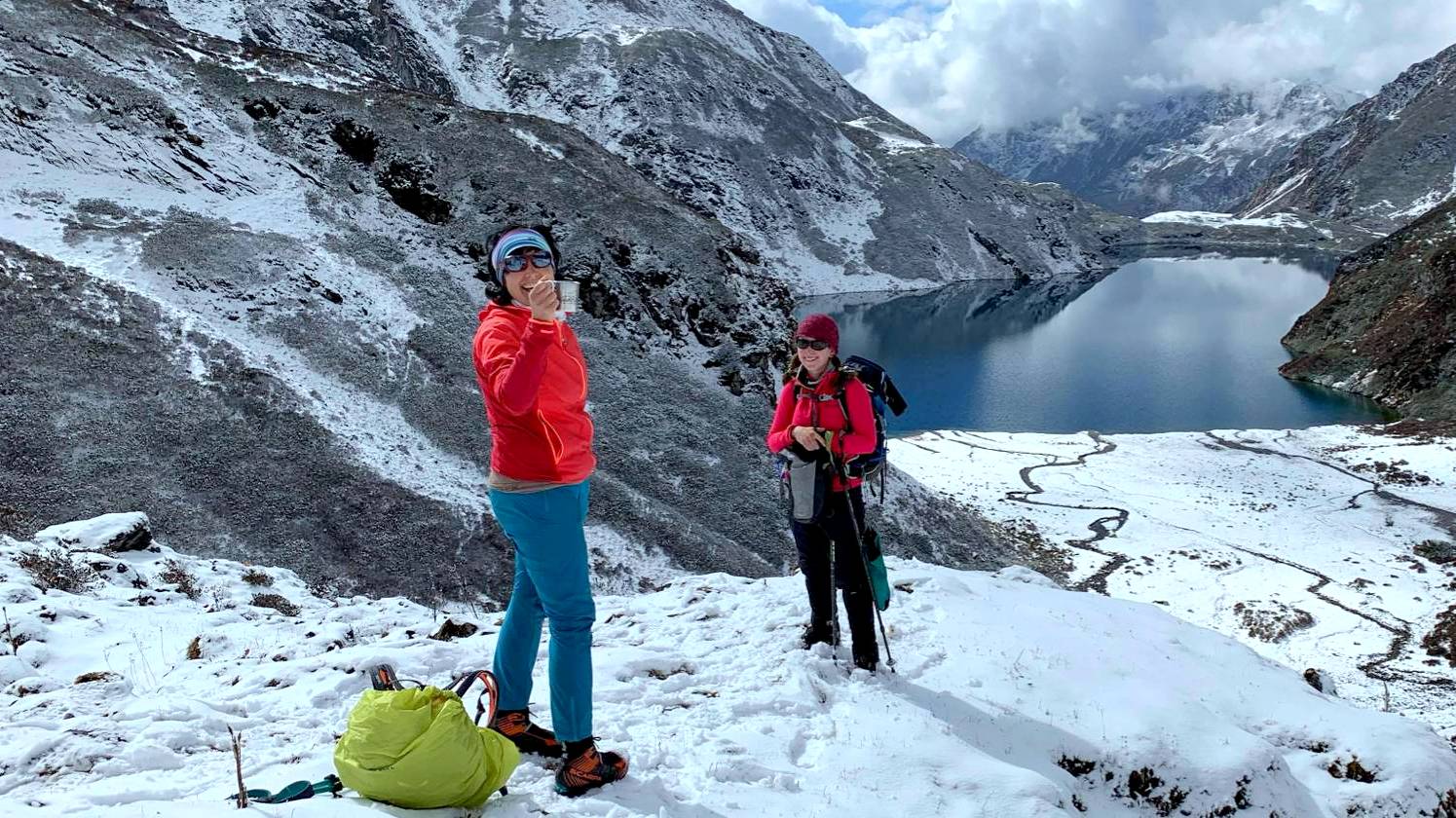
- Overview: The Snowman Trek extends for about 200 miles through the Bhutanese Himalayas, traversing through 11 high passes, many of which are over 16,000 feet. It typically takes around 25 to 30 days to complete, demanding a high level of fitness and stamina from its trekkers.
- Scenery: The trek provides panoramic views of some of the highest unclimbed peaks in the world. Trekkers pass through remote villages, ancient monasteries, and crystal-clear high-altitude lakes. The landscape varies from lush valleys to stark high-altitude deserts, providing a dynamic visual experience throughout the journey.
- Difficulty: Due to its length and the altitude, the Snowman Trek is known for its difficulty. The weather can be unpredictable, and conditions can change rapidly, which adds to the challenge. Altitude sickness is a significant risk on this trek, making acclimatization days essential.
- Cultural Experience: Despite the physical challenges, the trek offers unique cultural insights into the lives of the highlanders who inhabit northern Bhutan. These remote communities live much as they have for centuries, and their traditions and lifestyles are a stark contrast to the modern world.
- Wildlife: The region is also rich in biodiversity. Trekkers might spot blue sheep, marmots, and if very lucky, the elusive snow leopard. The trek also offers opportunities to see a variety of bird species, including vultures and eagles, that thrive in the high altitudes.
- Best Time to Go: The best months to undertake the Snowman Trek are between June and October, although the window of opportunity can be narrow due to the onset of snow by October which can block passes and make the trek unsafe.
- Preparation: Preparation for the Snowman Trek must be thorough, including physical training and gathering appropriate gear. Due to its remote nature, trekkers must be self-sufficient, and guided tours often include support teams with porters and yaks to carry supplies.
Embarking on the Snowman Trek is a serious adventure that offers an unforgettable journey through some of the most spectacular and unspoiled parts of the Himalayas. It’s a once-in-a-lifetime experience for those who are up for the challenge.
Jomolhari Trek
The Jomolhari Trek is one of Bhutan's most popular and rewarding high-altitude treks, attracting adventure seekers with its stunning landscapes, challenging paths, and rich cultural interactions. It's often celebrated for providing trekkers with a close-up view of Mt. Jomolhari, Bhutan’s second-highest peak, standing at over 7,326 meters (24,035 feet).
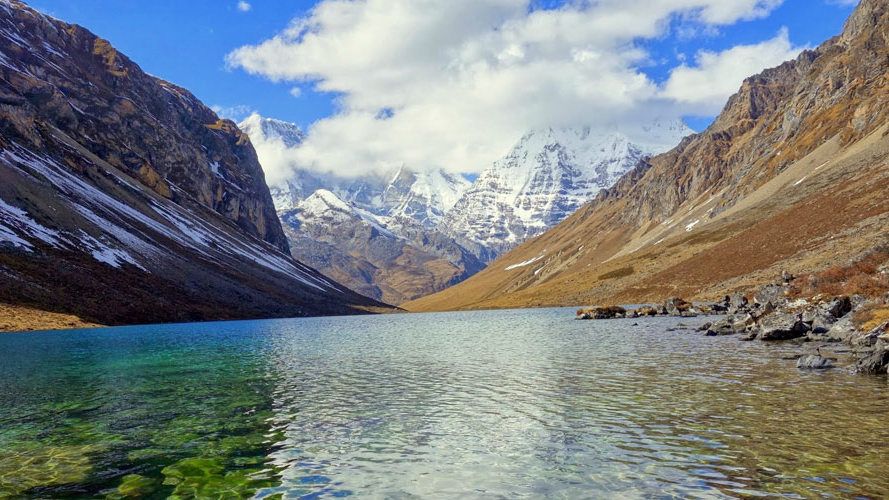
- Overview: Typically taking about 7 to 9 days to complete, the Jomolhari Trek offers a circuit that begins and ends in Paro. This trek not only challenges trekkers physically but also offers a deep dive into the natural and cultural heritage of Bhutan.
- Scenery: The trek traverses beautiful landscapes that include high mountain passes, remote valleys, and vibrant meadows filled with wildflowers. Trekkers are treated to spectacular views of Mt. Jomolhari, Jichu Drake, and Tsherimgang peaks. The path takes you through thick pine forests, and over high ridges that drop into canyons lined with rushing streams and waterfalls.
- Difficulty: The Jomolhari Trek is considered challenging due to its steep ascents and descents, high elevations, and the distance covered. The trek includes crossing passes such as Nyile La and Yale La, both over 4,800 meters (15,748 feet), which requires a good level of fitness and proper acclimatization to avoid altitude sickness.
- Cultural Experience: One of the unique aspects of the Jomolhari Trek is the opportunity to experience the traditional lifestyle of the Layap people, a semi-nomadic community living in close harmony with nature. Trekkers can visit ancient temples and fortresses (dzongs), interact with local villagers, and even witness festivals if timed right.
- Wildlife: The region is known for its diverse fauna, and trekkers may encounter species such as the blue sheep, marmots, and various birds. The area around Jomolhari is also part of the Jigme Dorji National Park, which is home to the elusive snow leopard.
- Best Time to Go: The ideal months to embark on the Jomolhari Trek are from late March to June and from September to November. These months generally offer clear weather and temperate conditions, ideal for high-altitude trekking.
- Preparation: Proper preparation for the Jomolhari Trek is crucial. This includes physical conditioning, securing necessary permits, and packing appropriate gear for cold and unpredictable mountain weather. Trekkers usually go with guided tours to enhance safety and to gain insightful knowledge about the area's geography and culture.
Embarking on the Jomolhari Trek is an adventure that promises breathtaking views, physical challenges, and a profound cultural immersion, making it a must-do for trekkers visiting Bhutan.
Druk Path Trek
The Druk Path Trek is one of Bhutan's most famous and scenic treks, offering a blend of cultural and natural wonders in a relatively short but varied route. Ideal for those who have limited time but still want a taste of high-altitude trekking in Bhutan, this journey connects the valleys of Paro and Thimphu and offers a rich experience in just 6 to 7 days.
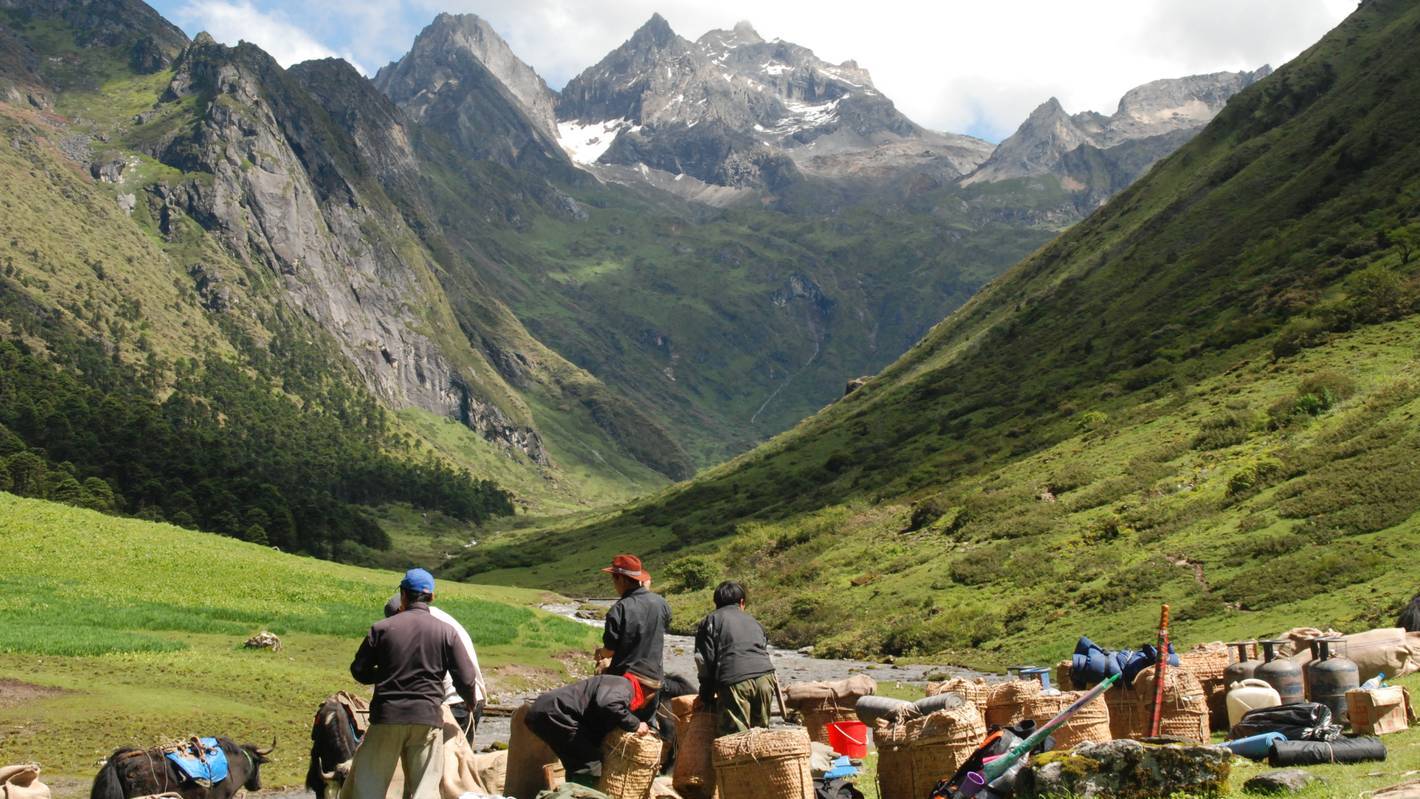
- Overview: The Druk Path Trek involves moderate to challenging hikes and reaches altitudes of up to 4,210 meters (13,812 feet). It passes through a stunning landscape of thick alpine forests, high ridges, and pristine lakes. Despite its shorter duration, the trek provides a wonderful introduction to the Himalayas.
- Scenery: As trekkers navigate the path, they are treated to spectacular views of snow-capped mountains, including Mt. Gangkar Puensum, the highest unclimbed peak in the world. The trail meanders past several remote lakes, each offering unique vistas and serene environments perfect for rest and reflection.
- Difficulty: The Druk Path Trek is considered moderately challenging. It involves navigating steep climbs and descents, rocky paths, and high-altitude conditions, making it necessary for trekkers to be reasonably fit and well-acclimatized to the altitude.
- Cultural Experience: This trek offers cultural insights as it passes by ancient lhakhangs (temples), dzongs (fortresses), and secluded villages. Highlights include visiting Phajoding Monastery and the stunning Simtokha Dzong, providing trekkers with a glimpse into Bhutan’s rich heritage and architectural marvels.
- Wildlife: The route crosses through areas rich in flora and fauna. Trekkers might see herds of blue sheep, various bird species, and if lucky, the elusive red panda. The forests are dense with rhododendrons and other high-altitude flora, which bloom vibrantly in the spring.
- Best Time to Go: The best times to undertake the Druk Path Trek are in the spring (March to May) and autumn (September to November). During these periods, the weather is generally clear, and the views are at their most spectacular.
- Preparation: Preparation for the Druk Path Trek includes packing essential gear for variable weather, from warm layers to rain protection. Fitness preparation is also crucial, as the high-altitude terrain demands endurance. It’s advisable to book through a reputable guide service that will handle logistics like permits, guides, and porters.
The Druk Path Trek is an exhilarating and accessible adventure for those looking to explore Bhutan’s extraordinary landscapes and cultural heritage within a compact timeframe.
Laya Gasa Trek
The Laya Gasa Trek is one of Bhutan's most beautiful and remote adventures, offering trekkers an exquisite blend of natural landscapes and cultural richness. Extending from the famous Jomolhari Trek, this trek continues further into the northern parts of Bhutan, leading to the culturally unique settlements of Laya and Gasa.
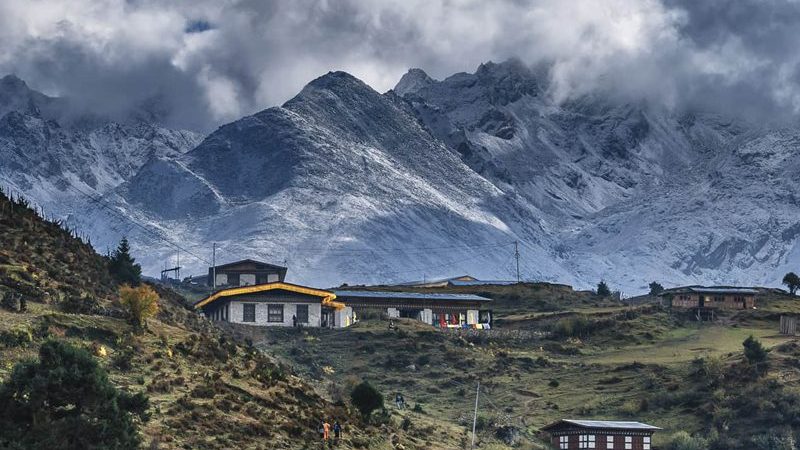
- Overview: The Laya Gasa Trek usually spans about 14 to 18 days, depending on weather conditions and the pace of the trekking group. It is considered one of the more challenging routes due to its length and the high altitudes involved, with passes exceeding 5,000 meters.
- Scenery: The trek provides dramatic views of some of the most pristine and unspoiled landscapes in Bhutan. Trekkers cross several high passes, offering panoramic views of the Himalayas, including Jomolhari, Jichu Drake, and Tsherimgang. The trail meanders through deep forests, alpine meadows rich with wildflowers, and high mountain passes draped in stunning vistas.
- Difficulty: The Laya Gasa Trek Difficulty is rated as challenging, not only due to its high-altitude passes such as Sinche La and Gobu La but also because of the length of the trek and the remote nature of the trail. Proper acclimatization is required to handle the altitude, and physical fitness is a must.
- Cultural Experience: This trek is particularly notable for its cultural experiences as it passes through the region of Laya, home to the Layap people, known for their distinct clothing and traditions. The trek also ends at the Gasa Hot Springs, where trekkers can relax and enjoy the therapeutic benefits of the natural hot springs.
- Wildlife: The region is part of the Jigme Dorji National Park, which is home to a variety of wildlife, including the elusive snow leopard, blue sheep, and the Himalayan black bear. Bird enthusiasts may also spot a variety of bird species, including the Bhutanese national bird, the raven.
- Best Time to Go: The Laya Gasa Trek is best undertaken in the spring (April to June) and autumn (September to November) months. During these times, the weather is generally stable, and the skies are clear, providing the best conditions for trekking and enjoying the views.
- Preparation: Preparation for the Laya Gasa Trek involves comprehensive planning in terms of gear, as weather conditions can vary drastically, and trekking at high altitudes requires specialized equipment. It's also advisable to engage with a knowledgeable local guide service that can provide logistical support, including permits, camping equipment, and meals.
The Laya Gasa Trek stands out as an unforgettable adventure for those who seek to immerse themselves in Bhutan's breathtaking natural beauty and delve deep into the cultural heart of the Himalayas.
Merak Sakteng Trek
The Merak Sakteng Trek is a unique journey that takes you deep into the heart of one of Bhutan’s most isolated and culturally distinctive regions. This trek offers an opportunity to explore the semi-nomadic lifestyle of the Brokpa people of the Merak and Sakteng villages, which are only accessible by foot.

- Overview: Typically spanning about 7 to 8 days, the Merak Sakteng Trek is less traveled compared to other popular treks in Bhutan, making it a perfect choice for those looking to experience something truly off the beaten path. The trek not only showcases the stunning landscapes of eastern Bhutan but also immerses trekkers in the unique culture of its inhabitants.
- Scenery: The trek traverses through diverse landscapes, from lush rhododendron forests to alpine meadows and high-altitude pastures. The region is known for its exceptional beauty, especially during the spring when the flowers are in bloom. Trekkers will encounter stunning views of the surrounding mountains and valleys that define the rugged terrain of eastern Bhutan.
- Difficulty: The Merak Sakteng Trek is considered moderately challenging. It involves navigating through several passes over 4,000 meters, with the highest point being the Nachung La pass. The paths can be steep and rugged, demanding good physical fitness and some trekking experience.
- Cultural Experience: This trek is particularly notable for its rich cultural exposure. The Brokpa communities of Merak and Sakteng are among the last to preserve their ancient traditions and lifestyles. Trekkers can witness unique cultural practices, traditional costumes, and the daily lives of these semi-nomadic people, which are distinctly different from other Bhutanese communities.
- Wildlife: The area is part of the Sakteng Wildlife Sanctuary, which is dedicated to protecting the mythical Yeti, believed by locals to inhabit the region. While spotting a Yeti might not be on the agenda, the sanctuary is home to red pandas, Himalayan black bears, and other wildlife unique to this part of the country.
- Best Time to Go: The best times to embark on the Merak Sakteng Trek are during the spring (April to June) when the rhododendrons are in full bloom, and in the autumn (September to November), when the skies are clear and the views are particularly striking.
- Preparation: Due to the isolated nature of the trek, thorough preparation is essential. This includes proper acclimatization to the altitude, packing suitable clothing for variable weather conditions, and ensuring that all necessary permits are in place. Opting for a guided trek can enhance the experience, as local guides provide invaluable insights into the culture and natural environment.
Embarking on the Merak Sakteng Trek offers an extraordinary opportunity to explore one of Bhutan’s less frequented regions, providing a glimpse into the lives of the Brokpa people and the stunning natural beauty of their homeland.
Gangtey Valley Trek
The Gangtey Valley Trek is a delightful and moderately easy trek that offers a unique blend of cultural insight and natural beauty. Situated in the picturesque Phobjikha Valley, known for its serene landscapes and as the winter home of the black-necked cranes, this trek is perfect for those who want a less strenuous yet profoundly enriching Himalayan experience.

- Overview: Typically lasting about 3 to 5 days, the Gangtey Valley Trek is accessible to a wide range of fitness levels, making it an ideal choice for families or those who prefer a gentler introduction to trekking in Bhutan. The trek covers a loop, starting and ending in the beautiful Gangtey Gompa monastery.
- Scenery: The trek unfolds across the floor of the glacial Phobjikha Valley, which sits at an elevation of around 3,000 meters. The valley is renowned for its stunning vistas of lush green meadows and dense forests that encircle a small, traditional village and the famous Gangtey Monastery. In the winter months, the area becomes a picturesque winter wonderland, providing a habitat for the endangered black-necked cranes.
- Difficulty: The Gangtey Valley Trek is considered easy to moderate in difficulty. It involves mostly gentle walks through the valley with some occasional climbs to nearby ridges, offering expansive views of the valley floor below. This trek does not reach the extreme altitudes of other Bhutanese treks, making it a more accessible option.
- Cultural Experience: The trek provides a wonderful opportunity to experience Bhutanese village life. The highlight is the Gangtey Gompa monastery, an important center of the Nyingmapa school of Buddhism, which adds a profound spiritual dimension to the trek. The local communities in the valley are known for their hospitality and the preservation of their unique cultural traditions.
- Wildlife: Apart from the black-necked cranes that visit the valley in the winter, the region is rich in wildlife, including red foxes, barking deer, and various species of birds. The valley is a significant conservation area for the cranes, and during the winter months, visitors can observe these graceful birds, often during the annual Black-necked Crane Festival.
- Best Time to Go: The best time to undertake the Gangtey Valley Trek is from September to November and from March to May. These months offer clear skies and moderate weather, ideal for trekking and wildlife viewing. For those interested in seeing the black-necked cranes, visiting from late October to mid-February is recommended.
- Preparation: Preparation for this trek is relatively minimal compared to higher altitude treks. However, it's still important to carry good walking shoes, appropriate clothing for variable weather, and basic trekking gear. Since the trek is less demanding, it allows for a more relaxed pace and the opportunity to thoroughly enjoy the natural and cultural surroundings.
The Gangtey Valley Trek is a wonderful way to explore one of Bhutan’s most beautiful valleys, offering a mix of natural beauty, wildlife, and cultural richness, all within a short and enjoyable trekking experience.
Dagala Thousand Lakes Trek
The Dagala Thousand Lakes Trek is an enchanting journey through a landscape dotted with numerous beautiful, high-altitude lakes in Bhutan. This trek not only offers stunning views of the Himalayan range but also provides trekkers with the unique opportunity to explore the serene and mystical lakes that give the trek its name.
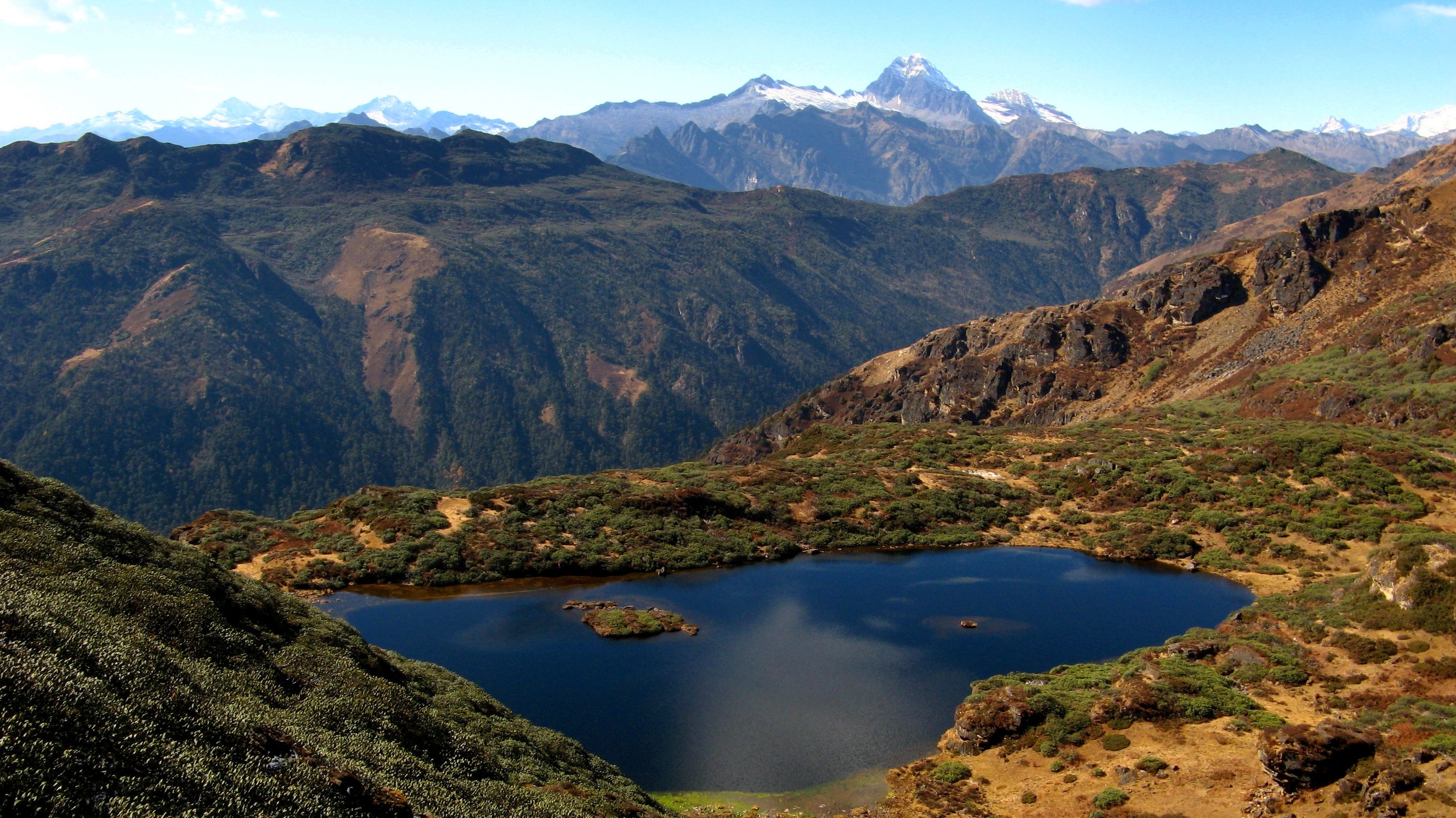
- Overview: The trek typically spans about 5 to 6 days, making it a moderate challenge for most trekkers. It traverses through the Dagala range, which is less frequented by tourists, offering a peaceful and secluded hiking experience.
- Scenery: As implied by its name, the Dagala Thousand Lakes Trek features a myriad of small to medium-sized lakes, each with its own unique charm. The trek provides exceptional views of the entire Himalayan range, including Mt. Everest, Mt. Jomolhari, Jichu Drake, and the Gangkar Puensum. The landscape around the lakes is varied, ranging from rocky outcrops to lush meadows that bloom with wildflowers during the spring and summer months.
- Difficulty: This trek is considered moderate in difficulty. It involves several climbs to high mountain passes, the highest being over 4,500 meters (14,764 feet). The altitude and length of the trek require good physical fitness and proper acclimatization to avoid altitude sickness.
- Cultural Experience: While the Dagala Thousand Lakes Trek is more focused on natural beauty than cultural interaction, it still offers glimpses into the pastoral life of the nomadic herders who seasonally graze their livestock in this region. Trekkers might encounter herders' camps and get an insight into their simple, yet content lifestyles.
- Wildlife: The region is rich in flora and fauna, with opportunities to see mountain goats, blue sheep, and a variety of bird species, including the Himalayan monal, Bhutan’s national bird. The diverse ecosystems supported by the lakes and surrounding vegetation also make for an interesting exploration for nature enthusiasts.
- Best Time to Go: The ideal months to undertake the Dagala Thousand Lakes Trek are in the spring (April to June) when the landscape is vibrant and full of life, and in the autumn (September to November) when the skies are generally clear, offering the best mountain views.
- Preparation: Preparation for the Dagala Thousand Lakes Trek should include packing appropriate gear for cold and unpredictable mountain weather, including waterproof clothing, good hiking boots, and layers for warmth. Navigation can be tricky in this less-traveled area, so going with a guide who knows the terrain is advisable.
The Dagala Thousand Lakes Trek is perfect for those who seek solitude and the beauty of nature, away from the more crowded routes. It offers a unique trekking experience filled with breathtaking panoramas and tranquil lakes, making it a memorable part of any visit to Bhutan.
Bhutan offers a remarkable array of trekking routes that cater to adventure enthusiasts looking to explore the natural and cultural richness of the Himalayas. From the daunting challenges of the Snowman Trek to the serene beauty of the Dagala Thousand Lakes Trek, each route presents a unique experience. Whether you're drawn to the spiritual depth and vibrant communities encountered along the Jomolhari Trek or the untouched, scenic landscapes of the Merak Sakteng Trek, Bhutan's trails promise unforgettable adventures. These treks not only challenge the body but also invigorate the spirit, making Bhutan a premier destination for trekkers around the globe.
FAQs of the Top Trekking Routes in Bhutan for Adventure Enthusiasts
Q: What is the best time of year to go trekking in Bhutan?
A: The best time to trek in Bhutan is during the spring (March to May) and autumn (September to November). These seasons offer stable weather, clear skies, and the best views of the Himalayas. The monsoon season (June to August) is generally avoided due to heavy rains and leeches on the lower trails.
Q: Do I need a guide to trek in Bhutan?
A: Yes, it is mandatory to have a guide for trekking in Bhutan. The government regulations require that all treks be organized through a registered tour operator in Bhutan. Guides are not only knowledgeable about the routes but also essential for your safety.
Q: What are the permit requirements for trekking in Bhutan?
A: All tourists (except citizens of India, Bangladesh, and the Maldives) need a visa to enter Bhutan. Additionally, trekking routes often require a separate permit, especially those that pass through protected areas or border zones. These permits are usually arranged by your tour operator.
Q: How physically demanding are the treks in Bhutan?
A: The difficulty of treks in Bhutan ranges from moderate to very challenging. Treks like the Snowman Trek are considered among the most difficult in the world due to high altitudes, long distances, and tough terrain. It's essential to assess your fitness level and choose a trek that matches your abilities.
Q: What should I pack for a trek in Bhutan?
A: Packing for a trek in Bhutan should include layers of clothing for varying temperatures, waterproof gear, good hiking boots, a sleeping bag suitable for cold climates, a first aid kit, and any personal medication. Don't forget to bring a camera to capture the stunning landscapes!
Q: Can I experience local culture during my trek?
A: Absolutely! Many treks in Bhutan offer rich cultural experiences, from visiting remote villages and monasteries to interacting with local herders. Treks like the Laya Gasa and Merak Sakteng are particularly known for their cultural immersion.
Q: What wildlife might I see while trekking in Bhutan?
A: The Himalayan region is home to a diverse range of wildlife. Depending on your trek and its location, you might see blue sheep, takins, red pandas, and various bird species. The Jomolhari and Laya Gasa treks pass through areas where you might even spot the elusive snow leopard.
Q: Are there any health concerns I should be aware of?
A: The primary health concern while trekking in high altitudes is Acute Mountain Sickness (AMS), which can affect anyone regardless of fitness level. It's crucial to acclimatize properly and stay hydrated. Also, ensure you have travel insurance that covers high-altitude trekking.
Q: What are the accommodation options on treks?
A: Accommodation on most treks in Bhutan is in tents, with your tour operator providing all the camping equipment. On some of the less demanding treks, there may be simple lodges or homestays available.
Q: How can I minimize my impact on the environment while trekking?
A: Practicing Leave No Trace principles is essential. This includes packing out all your trash, staying on designated trails to prevent erosion, and using biodegradable products. Bhutan places a strong emphasis on environmental conservation, and as visitors, it’s important to respect and uphold these values.
If you are looking for tour packages in Bhutan please click here
If you need any further information, please contact us, Email: at [email protected] , Phone (Whatsapp or Viber) +975-1755-663
